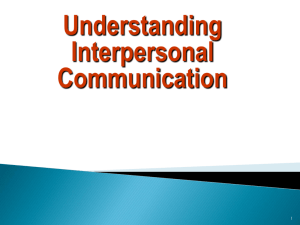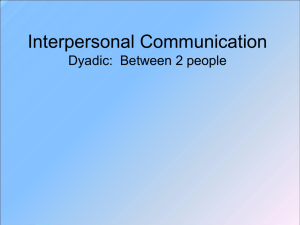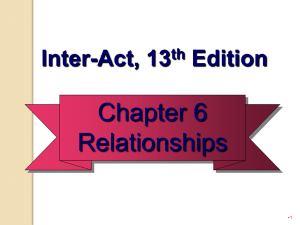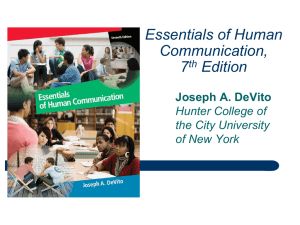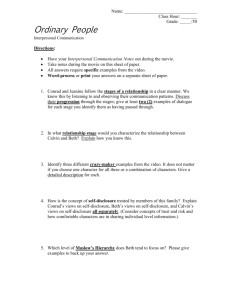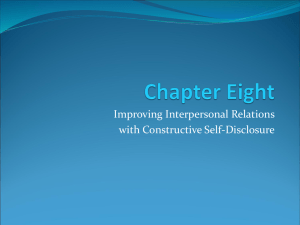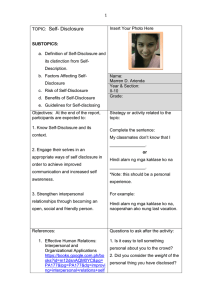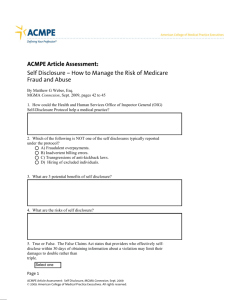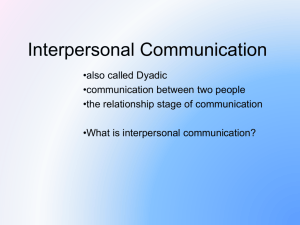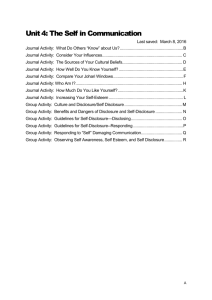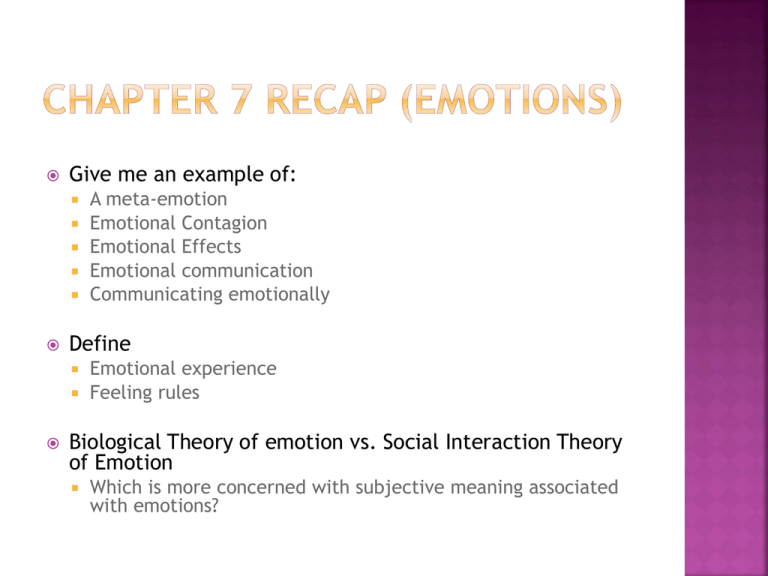
Give me an example of:
A meta-emotion
Emotional Contagion
Emotional Effects
Emotional communication
Communicating emotionally
Define
Emotional experience
Feeling rules
Biological Theory of emotion vs. Social Interaction Theory
of Emotion
Which is more concerned with subjective meaning associated
with emotions?
Chapter 8 Lecture/Recap
http://www.youtube.com/watch?v=fbtdtxNLh7A
“…personal information, shared intentionally,
that another person would have trouble finding
out without being told” (p. 155).
“I decided to wear pink today”
“I decided to wear pink today in support of my loved
ones who have battled breast cancer”
Verbal behaviors (intentional)
“I really have a crush on Will but no one knows
because I’m afraid he won’t like me back”
VERSUS
“You blush every time Will comes around—you must
have a crush on him!”
Must
What, how, how much
Must
be INTENTIONAL
trust the individual
How do we know?
Disclosing
private information
Private (reflection of self-concept) vs. public
(our public image)
Level of risk involved -- WHY?
Private
vs. Public
History vs. Story
More risk associated with story
Individual
differences (ties to subjectivity)
The need for openness and disclosure
Type
and life of relationship (3 patterns—p.
16o)
Disclosure often levels off or decreases
Framing disclosure -- based on relationship type
Example:(8:00 mark)
http://www.youtube.com/watch?v=puObmB1Ga3Q
Culture
Sex
and Gender
Great deal of disclosure in few interactions
Usually occurs between 2 people in close
relationships
Exceptions?
Ex: 3 friends discussing a break up; the bus rider
phenomenon
http://www.youtube.com/watch?v=H8p2dYpeO6U
Reciprocal process
Immediate?
Matching self-disclosure vs. concern
Example: Clip (Charlotte and Miranda)
Occurs over time
Relationship development linked with self-disclosure
Dialectics
Theory
Tension – privacy vs. disclosure
Four ways to address this tension
Cyclic alternation (disclose or keep private at
different times)
Segmentation (certain topics for separate settings)
Selection (choose one side; ignore the other)
Integration (neutralizing—happy medium,
disqualifying—taboo topics, reframing)
Social Penetration Theory/Model
http://www.youtube.com/watch?v=_bMcXVe8zIs –
why is this an example of penetration theory?
Breadth vs. Depth
Application Exercise #8-Part 1 (5pts): Draw your
onion! Consider each level as more information. Also
consider different relationships. Where would you put
discussions of:
Your relationship with a significant other
Your political views
Your religious views
Your goals and aspirations
General information about your family
Detailed information about your family
Detailed information about your medical history
Your hobbies, interest, favorite things
Your pet peeves and dislikes
What would it take for you to peel back each layer?
Johari
(Joseph + Harry) Window
Four panes: Open, Hidden, Blind, and Unknown
Application Exercise #8-Part 2 (5pts): Draw out
your Johari Window for these different
encounters/relationships:
With your parent
With your best friend
With your professor
Psychological
(e.g. catharsis) or physical well
being
Self awareness
Relationships
Begin a relationship
Maintain a relationship
Satisfy expectations of a good relationship
Escalate a relationship
To
avoid hurt/rejection
Consider “ambushing” from our discussion on
listening
To
avoid conflict/protect a relationship
To keep image and/or individuality
To reduce stress
Owning
(I-Statements)
Honesty
Consistency
Non-distracting
verbal cues
Relevancy (consider the context)
To situation and conversation
Risks
vs. Benefits analysis
Predict reactions/responses (of the receiver)
and effects (on the relationship)
Appropriateness
Amount, type, receiver
Get
in groups for discussion; active discussion
part of class participation/attendance
One person—take notes about discussion. Is
self-disclosure necessary? Why or why not?
Is privacy more important? Why or why not?
Tie both to interpersonal communication
What
is your view on technology and how it
has impacted self-disclosure?
Do you think there has been a positive or
negative effect? Explain.
Provide examples
How do those “effects” impact interpersonal
communication?
Discuss groups
Proposal Form Due: March 24th/25th
Form on Faculty Webpage


